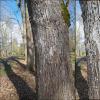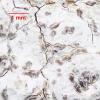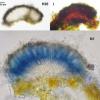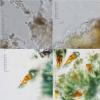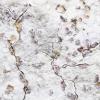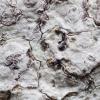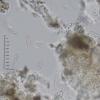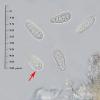
20-12-2025 23:08
Patrice TANCHAUDBonsoir, récolte sur sol sablonneux dans l'arri�

21-12-2025 09:32
Hello.A tiny ascomycete found embedded in wood in

20-12-2025 15:47
Mirek GrycHi.These grew on pine wood that was heavily covere

18-12-2025 21:17
Pol DebaenstThe identification took me to Byssonectria deformi

15-12-2025 07:09
 Danny Newman
Danny Newman
indet. Rutstroemiaceae sp. on unk. fallen leavesMc

19-12-2025 10:10
Patrice TANCHAUDBonjour, récolte réalisée en milieu dunaire, a

18-12-2025 17:23
 Bruno Coué
Bruno Coué
Bonjour,je serais heureux d'avoir votre avis sur c
Arthonia sp.
Gonzalez Garcia Marta,
28-03-2022 13:51
Talo blanco de 15 x 5 cm de longitud con apotecios redondeados o alargados, de color crema, pruinosos, inmersos en el talo, de 0,2 x 1 mm de longitud. Apotecio I+rojo. K/I+ azul. Esporas hialinas, elípticas, con los polos redondeados y uno de los extremos mas estrecho que el otro. Esporas con 4 septos de 16-20x 7 µm. Excípulo poco desarrollado, hipotecio de color claro de hasta 100 micras de altura. Epitelio marrón grisaceo que se vuelve verde oliva al tratamiento con KOH. Talo C-, P-, K-. Fotobionte trentepholia. Conidios no observados.
Zdenek Palice,
28-03-2022 15:42
Re : Arthonia sp.
Hallo,
it could be Reichlingia zwackhii, theoretically the thallus should contain 2'-O-methylperlatolic acid
best
Zdenek
it could be Reichlingia zwackhii, theoretically the thallus should contain 2'-O-methylperlatolic acid
best
Zdenek
Gonzalez Garcia Marta,
28-03-2022 16:27
Re : Arthonia sp.
Hi Zdenek
Había pensado en R.zwackhii, pero la había desechado por que la descripción dice que la celula apical es mas engrosada (the apical cell enlarged) y en la mayoría de mis observaciones no es así... La descripción de Pachnolepia pruinata tambien me gusta, pero el talo no es C+.
Agradezco tus opiniones.
Había pensado en R.zwackhii, pero la había desechado por que la descripción dice que la celula apical es mas engrosada (the apical cell enlarged) y en la mayoría de mis observaciones no es así... La descripción de Pachnolepia pruinata tambien me gusta, pero el talo no es C+.
Agradezco tus opiniones.
Zdenek Palice,
28-03-2022 17:18
Re : Arthonia sp.
Dear Marta, me parece mas que R. zwackhii. Anyway, to me it looks more like Reichlingia zwackhii. I can see at least some enlarged cells, it is kind of subjectivity what is still enlarged cell and what not. I saw very similar material from the Caucasus.
There were some misunderstandings as for using the name Arthonia/Reichlingia zwackhii in literature in the past, and was it sometimes referred as an initial parasite on Phlyctis argena. Possibly because of the existance of a lichenicole with the same species epithet - Leciographa (Phacographa) zwackhii. This seems to be an obligate parasite on Phlyctis argena. But possibly also Reichlingia and Phlyctis may sometimes grow together, and then results of chemical analyses might be biased.
But the chemistry should be reliable (if you have a possibility to do TLC) as for this species placing in Reichlingia. Recommend to consult your specimen with Andreas Frisch (andreas.frisch@ntnu.no), who is the expert on these things and a willing person.
Zdenek
There were some misunderstandings as for using the name Arthonia/Reichlingia zwackhii in literature in the past, and was it sometimes referred as an initial parasite on Phlyctis argena. Possibly because of the existance of a lichenicole with the same species epithet - Leciographa (Phacographa) zwackhii. This seems to be an obligate parasite on Phlyctis argena. But possibly also Reichlingia and Phlyctis may sometimes grow together, and then results of chemical analyses might be biased.
But the chemistry should be reliable (if you have a possibility to do TLC) as for this species placing in Reichlingia. Recommend to consult your specimen with Andreas Frisch (andreas.frisch@ntnu.no), who is the expert on these things and a willing person.
Zdenek
Gonzalez Garcia Marta,
28-03-2022 18:20
Re : Arthonia sp.
Muchas gracias Zdenek.
Gonzalez Garcia Marta,
29-03-2022 19:49
Re : Arthonia sp.
Buenas tardes Zdenek,
Hemos escrito a Andreas Frisch y nos ha sugerido lo siguiente, (corto y pego):
I'm inclined to call this Arthonia (Pachnolepia) pruinata because of the spores lacking a clearly enlarged apical cell and spore shape as well. But from pictures alone it is difficult to be sure. I also have not seen this strong red coloration of the hymenial gels in iodine in Reichlingia so far (usually pale to deep blue, but this may depend on concentration). We have recently found a Pacholepia pruinata specimen in Norway lacking arthoniaic acid (Frisch et al. 2020) that was confirmed by B. Coppins.
Hemos escrito a Andreas Frisch y nos ha sugerido lo siguiente, (corto y pego):
I'm inclined to call this Arthonia (Pachnolepia) pruinata because of the spores lacking a clearly enlarged apical cell and spore shape as well. But from pictures alone it is difficult to be sure. I also have not seen this strong red coloration of the hymenial gels in iodine in Reichlingia so far (usually pale to deep blue, but this may depend on concentration). We have recently found a Pacholepia pruinata specimen in Norway lacking arthoniaic acid (Frisch et al. 2020) that was confirmed by B. Coppins.
As Zdenek mentioned, TLC might be helpful in confirming presence or absence of arthoniaic acid.
De momento no tengo acceso a TLC por lo que solo me queda seguir aprendiendo. Muchas gracias.
Zdenek Palice,
30-03-2022 00:01
Re : Arthonia sp.
Marta,
bueno, verdad. Andreas is the highest authority in Arthoniales so we should believe him.
Buenas noches. Zdenek
bueno, verdad. Andreas is the highest authority in Arthoniales so we should believe him.
Buenas noches. Zdenek

